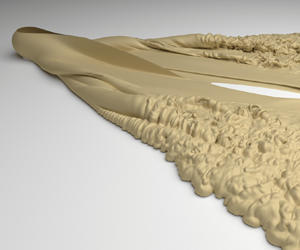Crossref Citations
This article has been cited by the following publications. This list is generated based on data provided by
Crossref.
Muñoz-Royo, Carlos
Ouillon, Raphael
El Mousadik, Souha
Alford, Matthew H.
and
Peacock, Thomas
2022.
An in situ study of abyssal turbidity-current sediment plumes generated by a deep seabed polymetallic nodule mining preprototype collector vehicle.
Science Advances,
Vol. 8,
Issue. 38,
Pei, Binbin
Li, FangBo
Luo, Zhengyuan
Zhao, Liang
and
Bai, Bofeng
2022.
Dynamics of mixing flow with double-layer density stratification: Enstrophy and vortical structures.
Physics of Fluids,
Vol. 34,
Issue. 10,
Ungarish, M.
2022.
On simple models for gravity currents from moving sources.
Journal of Fluid Mechanics,
Vol. 952,
Issue. ,
Helmons, Rudy
de Wit, Lynyrd
de Stigter, Henko
and
Spearman, Jeremy
2022.
Dispersion of Benthic Plumes in Deep-Sea Mining: What Lessons Can Be Learned From Dredging?.
Frontiers in Earth Science,
Vol. 10,
Issue. ,
Blanchette, François
2022.
Shallow-water equations and box model simulations of turbidity currents from a moving source.
Physical Review Fluids,
Vol. 7,
Issue. 8,
Ouillon, Raphael
Muñoz-Royo, Carlos
Alford, Matthew H.
and
Peacock, Thomas
2022.
Advection–diffusion settling of deep-sea mining sediment plumes. Part 2. Collector plumes.
Flow,
Vol. 2,
Issue. ,
Ali, W.
Enthoven, D.
Kirichek, A.
Chassagne, C.
and
Helmons, R.
2022.
Effect of flocculation on turbidity currents.
Frontiers in Earth Science,
Vol. 10,
Issue. ,
Allen, P. A.
Dorrell, R. M.
Harlen, O. G.
Thomas, R. E.
and
McCaffrey, W. D.
2022.
Mixing in density- and viscosity-stratified flows.
Physics of Fluids,
Vol. 34,
Issue. 9,
Peacock, Thomas
and
Ouillon, Raphael
2023.
The Fluid Mechanics of Deep-Sea Mining.
Annual Review of Fluid Mechanics,
Vol. 55,
Issue. 1,
p.
403.
Elerian, Mohamed
Huang, Ziyang
van Rhee, Cees
and
Helmons, Rudy
2023.
Flocculation effect on turbidity flows generated by deep-sea mining: A numerical study.
Ocean Engineering,
Vol. 277,
Issue. ,
p.
114250.
Guo, Xingsen
Luo, Qianyu
Stoesser, Thorsten
Hajaali, Arthur
and
Liu, Xiaolei
2023.
Evolution of high-density submarine turbidity current and its interaction with a pair of parallel suspended pipes.
Physics of Fluids,
Vol. 35,
Issue. 8,
Xie, Jiafeng
Hu, Peng
Zhu, Chenlin
Yu, Zhaosheng
and
Pähtz, Thomas
2023.
Turbidity currents propagating down an inclined slope: particle auto-suspension.
Journal of Fluid Mechanics,
Vol. 954,
Issue. ,
Vowinckel, Bernhard
Zhao, Kunpeng
Zhu, Rui
and
Meiburg, Eckart
2023.
Investigating cohesive sediment dynamics in open waters via grain-resolved simulations.
Flow,
Vol. 3,
Issue. ,
Chen, Si-Yuan Sean
Ouillon, Raphael
Muñoz-Royo, Carlos
and
Peacock, Thomas
2023.
Oceanic bottom mixed layer in the Clarion-Clipperton Zone: potential influence on deep-seabed mining plume dispersal.
Environmental Fluid Mechanics,
Vol. 23,
Issue. 3,
p.
579.
Liu, Shihang
Yang, Jianmin
Lu, Haining
Sun, Pengfei
and
Zhang, Bei
2023.
A Numerical Investigation of the Dynamic Interaction between the Deep-Sea Mining Vehicle and Sediment Plumes Based on a Small-Scale Analysis.
Journal of Marine Science and Engineering,
Vol. 11,
Issue. 7,
p.
1458.
Liu, Shihang
Yang, Jianmin
Lyu, Haining
Sun, Pengfei
and
Zhang, Bei
2024.
Experimental and numerical investigation of the effect of deep-sea mining vehicles on the discharge plumes.
Physics of Fluids,
Vol. 36,
Issue. 3,
Newland, E.L.
and
Woods, A.W.
2024.
The dynamics of impinging plumes from a moving source.
Journal of Fluid Mechanics,
Vol. 982,
Issue. ,
Bai, Tianbao
Zhao, Yong
Zhou, Yinqing
and
Huang, Kun
2024.
Numerical simulation and analysis of initial plume discharge of deep-sea mining.
Ocean Engineering,
Vol. 310,
Issue. ,
p.
118794.
Sha, Fei
Xi, Mingshuai
Wen, Zhijie
Chen, Xuguang
Zuo, Yuhang
Xu, Jingze
Zhang, Minglong
and
Niu, Hongying
2024.
A review on plumes generation and evolution mechanism during deep-sea polymetallic nodules mining.
Ocean Engineering,
Vol. 298,
Issue. ,
p.
117188.
Stoffers, H.
Devolder, B.
Ramos, P.
and
Heiler, J.
2024.
The Seafloor Nodule Collector: Best Available Techniques and Future Developments.




